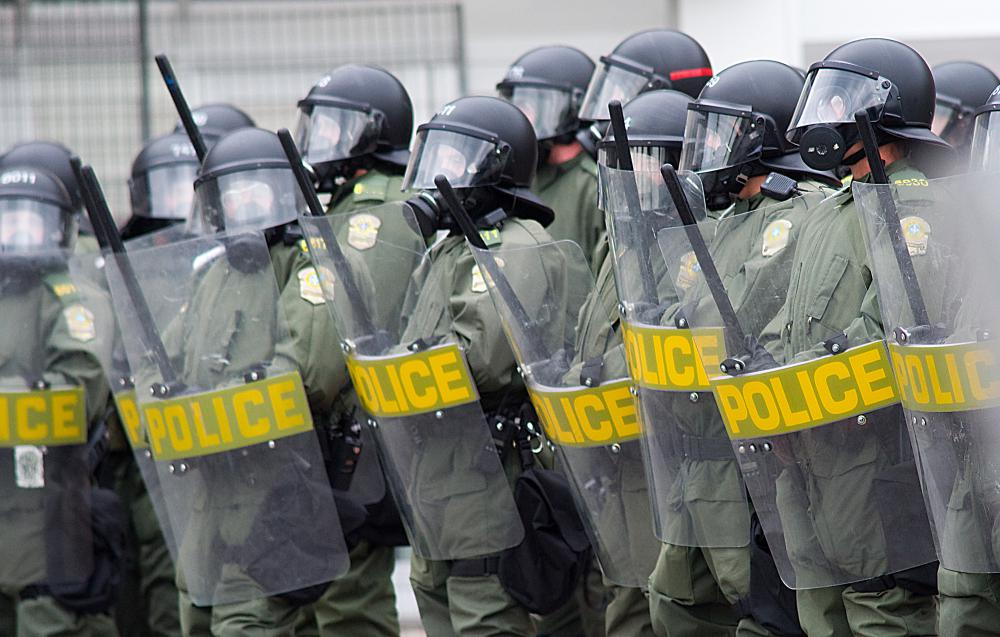At WiseGEEK, we're committed to delivering accurate, trustworthy information. Our expert-authored content is rigorously fact-checked and sourced from credible authorities. Discover how we uphold the highest standards in providing you with reliable knowledge.
What Is CS Gas?
CS gas is a non-lethal chemical agent used primarily as a crowd control and riot-suppression tool. It causes severe and debilitating reactions in the tear ducts and mucus membranes. This agent was first used in the late 1950s and is widely used to combat civil unrest. Modern gas masks offer excellent protection against CS gas.
This chemical compound was first isolated in 1928 and is named for the men, Corson and Stoughton, who first developed its active ingredient. This ingredient, 2-chlorobenzalmalononitrile is mixed with other chemicals to turn it into a gas. Most commonly this chemical agent is deployed using small grenade-like canisters, which may be thrown or launched. Spray delivery systems are also sometimes used.
The most common name for this compound is “tear gas”. This name derives from the most prominent physical effects of the gas. Other chemical agents with similar debilitating but non-lethal effects may also be referred to as “tear gas," however.

Reactions to CS gas vary to some extent, but are typically both painful and debilitating. The substance irritates the eyes and mucous membranes, which makes vision difficult. Breathing after exposure to CS gas is also difficult and can be quite painful. Many people exposed to this substance find it impossible to breathe through their nostrils. Other physical effects, including pain and nausea, are also not uncommon.

International treaties prohibit the use of CS gas during warfare, as it is considered a chemical weapon. These treaties do not ban its use by police against civilians, however. It is widely used as a riot control agent and crowd dispersal tool. Police are often reluctant to use it in confined spaces, as the effects of CS gas can induce dangerous panic when no easy path of escape from the chemical agent is available.
Opinion remains divided over the dangers posed by exposure to this gas. It is generally accepted that the gas is non-lethal, but may pose additional risks for people with specific health conditions. Asthmatics, for instance, may experience more severe difficulties.
Modern gas masks are highly effective in protecting a wearer against the effects of this gas. The compound may still cause irritation of the skin, however. This occurs because the chemical irritant can penetrate into pores, and this causes a painful reaction. Heavy clothing can limit this effect, as can taking care not to rub areas that are exposed to CS gas. Warm weather exacerbates the topical effect of the gas, because sweating causes pores to open wider.
AS FEATURED ON:
AS FEATURED ON:












Discussion Comments
They use CS Gas capsules on us in the Marines in the gas chamber, testing our gas masks once a year (or more, if they take a fancy to it). This was over 20 years ago, so my memory has faded some but I think they would burn off maybe 2 or 3 capsules in a session.
You would come out with eyes stinging badly, along with your skin and all of the contents of your sinuses. One time our “Glo-worm” as we called our unit’s NBC specialist decided to really give us a workout and burned off 6 or 8 capsules. He really decided to make things all the worse by making us do jog in place, do push-ups and jumping jacks to get our heart and breathing elevated and make us sweat worse. All the while he’s walking around in it cool as a cucumber without a mask.
A lady jogging down the street often carried CS spray to use as dog repellent. I met her while walking one day, and when I asked her if the scary dogs up the road ever chased her, she told me about the spray.
One day, she used it on my dog! I have a big weimaraner who likes to chase things, and she was jogging with her little Jack Russell terrier. My dog started chasing them, and she was afraid that it might hurt her little dog, so she whipped out the spray.
I saw it happen, but right when she aimed for my dog’s face, it turned around quickly, and the spray hit its rear instead. My dog screamed and ran home. She kept squatting and whining. When she walked, she remained in a half-squatting position, and this continued for about an hour before she recovered.
My brother found himself in the wrong place at the wrong time. He was trapped in the middle of a crowd when a riot broke out, and the police used CS gas to break it up.
He told me that his eyes immediately closed. He could not open them for awhile. He could only breathe through his mouth, and even that was painful. He kept coughing, and he felt like he might vomit.
Even after the initial effects faded, he experienced pain in his skin, nose, and eyes for days. He now has a fear of crowds and avoids them like the plague.
My friend has a triple action pepper spray that contains CS gas. She gave it to me to take on vacation for protection, because I was going to the beach by myself. She told me to be careful with it, because one of her friends accidentally sprayed himself because he thought it was a small flashlight.
I later met this friend, and he told me that the burning was unlike anything he had ever experienced. It burned severely for about an hour, and his eyes were still swollen when he woke up the next morning. To make matters worse, he had rubbed his eyes, which you should never do.
Post your comments